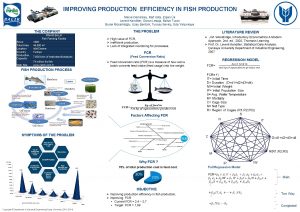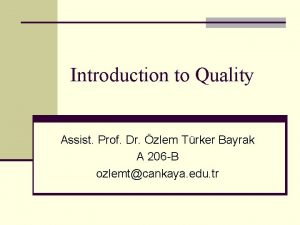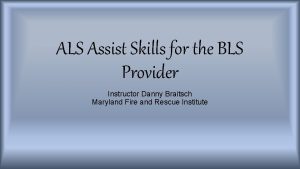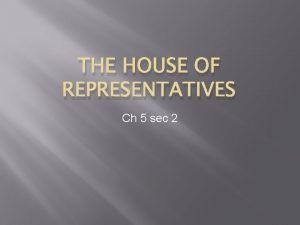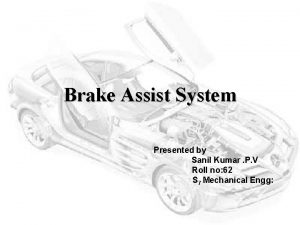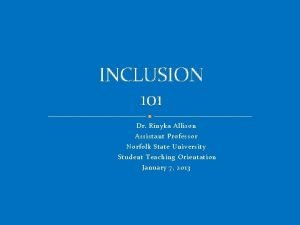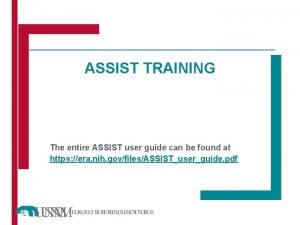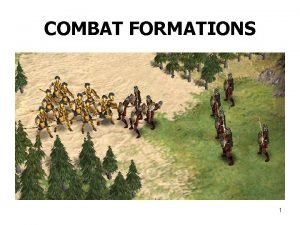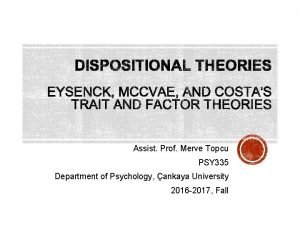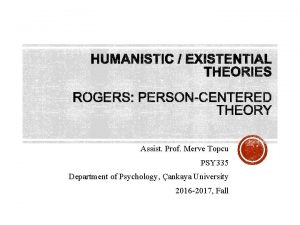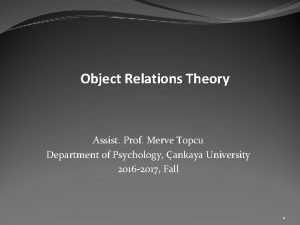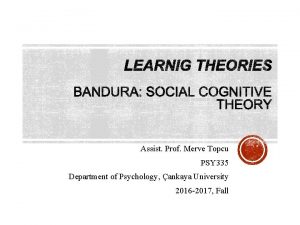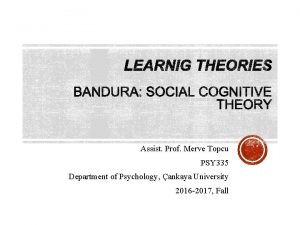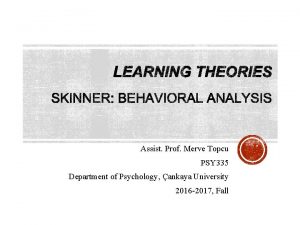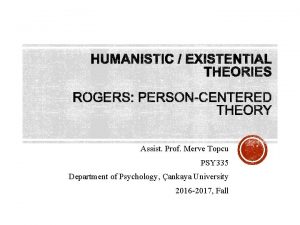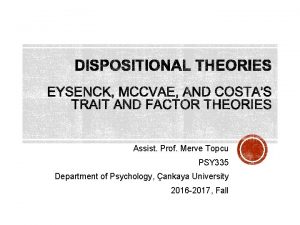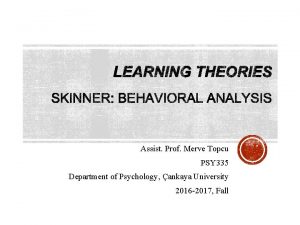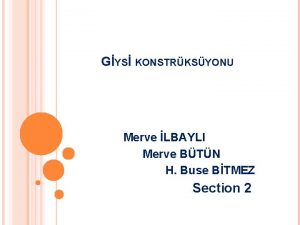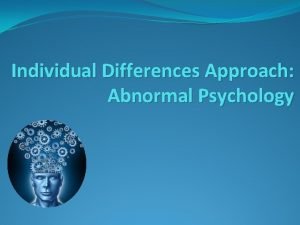Individual Psychology Assist Prof Merve Topcu Department of








































- Slides: 40

Individual Psychology Assist. Prof. Merve Topcu Department of Psychology, Çankaya University 2016 -2017, Fall

Who is Adler? • Born in 1870, Wien – Third child of seven – Apparent physical comfort, but miserable in childhood – Known for his efforts at outdoing his older brother • Received a medical degree in 1895 • Married in 1897 – Eventually had four children – Only son became a psychiatrist and continued Adler’s work • Influenced by Marx’s philosophy • Influence on Horney, Maslow, Rogers

Who is Adler? • Joined Freud’s discussion group in 1902 – Adler’s views were initially compatible with Freud’s • Adler’s views changed and he began to criticize Freud’s theories • In 1911, Adler and nine others broke away from Freud and formed “The Society for Individual Psychology” • Involvement in WWI helped develop the concept of social interest • Died in 1937

Individual Psychology 1. The one dynamic force behind people's behavior is the striving for success or superiority 2. People's subjective perceptions shape their behavior and personality 3. Personality is unified and self-consistent 4. The value of all human activity must be seen from the viewpoint of social interest 5. The self-consistent personality structure develops into a person's style of life 6. Style of life is molded by people's creative power

1. The one dynamic force behind people's behavior is the striving for success or superiority • • Motivating force the striving for perfection A single "drive" or motivating force lies behind all our behavior and experience • • • Personal responsibility to shaping personality Present is shaped by person’s view of future Psychologically healthy people are aware of themselves • • Superiority or success The desire we all have to fulfill our potentials, to come closer and closer to our ideal Similar to the more popular idea of self-actualization Critic to unconscious Psychologically unhealthy individuals strive for personal superiority, whereas psychologically healthy people seek success for all humanity

1. The one dynamic force behind people's behavior is the striving for success or superiority • Aggression drive--- the reaction we have when other drives (e. g. , the need to eat, be sexually satisfied, get things done, or be loved) are frustrated – Masculine protest • A universal drive • Have role in abnormal development • will to power or a domination of others • E. g. , In many cultures boys are often held in higher esteem than girls are • Better be called the assertiveness drive • Lastly, called striving for superiority • Regardless of the motivation for striving, each individual is guided by a final goal

1. The one dynamic force behind people's behavior is the striving for success or superiority • Final goal – People strive toward a final goal of either personal superiority or the goal of success for all humankind – fictional & no objective existence – unifies personality and renders all behavior comprehensible – Each person has the power to create a personalized fictional goal – The product of the creative power; that is, people's ability to freely shape their behavior and create their own personality – No effect of genetics or environment – Set by the time children reach 4 or 5 years of age

1. The one dynamic force behind people's behavior is the striving for success or superiority • Compensation • Striving to overcome • We all have problems, short-comings, inferiorities of one sort or another • The striving force itself is innate, but its nature and direction are due both to feelings of inferiority and to the goal of superiority • Our personalities could be accounted for by the ways in which we do -- or do not -- compensate or overcome those problems • Later, however, Adler rejected compensation as a label for the basic motive, because compensation makes it sound as if it is people’s problems that cause them to be what they are

1. The one dynamic force behind people's behavior is the striving for success or superiority • Personal superiority • Goals are personal & no interest of others • May be in the form of social interest but motivated by overcompensation • Healthy individuals • concerned with goals beyond themselves • capable of helping others without demanding or expecting a personal payoff • able to see others not as opponents but as people with whom they can cooperate for social benefit

2. People's subjective perceptions shape their behavior and personality • Subjective perceptions – the manner in which they strive is not shaped by reality but by their subjective perceptions of reality • by their fictions – expectations of the future • Fictionalism – This subjective, fictional final goal guides our style of life, gives unity to ow personality – Not real, acting as if real – People are motivated not by what is true but by their subjective perceptions of what is true • Teleology is an explanation of behavior in terms of its final purpose or aim – opposed to causality – considers behavior as springing from a specific cause • Physical deficiencies alone do not cause a particular style of life; they simply provide present motivation for reaching future goals

3. Personality is unified and self-consistent • The term individual psychology – each person is unique and indivisible – Becoming defensive against unpredictability • Ways in which the entire person operates with unity and selfconsistency – Organ dialect • all separate actions and functions can be understood only as parts of the goal • The disturbance of one part of the body cannot be viewed in isolation • the deficient organ expresses the direction of the individual's goal – Concious & unconscious • the harmony between conscious and unconscious actions • the unconscious, part of the goal that is neither clearly formulated nor completely understood by the individual

4. The value of all human activity must be seen from the viewpoint of social interest • Social interest – Based on an innate disposition, but it has to be nurtured to survive • Babies and small children often show sympathy for others without having been taught to do so – Sense of caring for family, for community, for society, for humanity, and even for life – a feeling of oneness with all humanity • A matter of being useful to others • perfection for all people in an ideal community – marriage and parenthood is a task for social interest – Influence of environment – Barometer for normality


5. The self-consistent personality structure develops into a person's style of life • Style of life – includes a person's goal, self-concept, feelings for others, and attitude toward the world – the product of the interaction of heredity, environment, and a person's creative power – established by age 4 or 5 – Ability to choose new ways of reacting to their environment – express their social interest through action • 3 major problems of life – neighborly love – sexual love – occupation

6. Style of life is molded by people's creative power • Style of life – Creative power • the freedom to create her or his own style of life. • all people are responsible for who they are and how they behave • Way to solve problems • ‘the law of the low doorway’ – Neuroticism

Abnormal development ‘The creative power endows humans, within certain limits, with the freedom to be either psychologically healthy or unhealthy and to follow either a useful or useless style of life. ’ • Underdeveloped social interest – Neurotics • tend to set their goals too high • live in their own private world • Have rigid and dogmatic style of life • Overconcerned w/ themselves & care little about others

Abnormal development • Neurosis – a matter of insufficient social interest – 3 types 1. the ruling type 2. the getting type 3. the avoiding type

Abnormal development • Neurosis: The Ruling Type – From childhood on, they are characterized by a tendency to be rather aggressive and dominant over others. – The strength of their striving after personal power is so great they tend to push over anything or anybody who gets in their way – The most energetic of them are bullies and sadists; – Somewhat less energetic ones hurt others by hurting themselves, and include alcoholics, drug addicts, and suicides

Abnormal development • Neurosis: The getting type – They are relatively passive – make little effort to solve their own problems – Instead, they rely on others to take care of them – Frequently use charm to persuade others to help them

Abnormal development • Neurosis: The avoiding type – These have the lowest levels of energy and only survive by essentially avoiding life -- especially other people – When pushed to the limits, they tend to become psychotic, retreating finally into their own personal worlds

Abnormal development • Adler, like Freud, saw personality or lifestyle as something established quite early in life • Basic childhood situations that most contribute to a faulty lifestyle 1. Exaggerated Physical Deficiencies 2. Pampered Style of Life 3. Neglected Style of Life

Abnormal development • Exaggerated Physical Deficiencies – must be accompanied by accentuated feelings of inferiority – They tend to be overly concerned with themselves – lack consideration for others – feel as if they are living in enemy country – fear defeat more than they desire success – life's major problems can be solved only in a selfish manner

Abnormal development • Pampered Style of Life – the heart of most neuroses – weak social interest but a strong desire to perpetuate the pampered – parasitic relationship with one or both of their parents – expect others to look after them, overprotect them, and satisfy their needs – characterized by extreme discouragement, indecisiveness, oversensitivity, impatience, and exaggerated emotion, especially anxiety

Abnormal development • Neglected Style of Life – Children who feel unloved and unwanted – Abused and mistreated children – little confidence in themselves – tend to overestimate difficulties connected with life's major problems – distrustful of other people and are unable to cooperate for the common welfare – feel alienated from all other people – more suspicious

Safeguarding tendencies • Enable people to hide their inflated self-image and to maintain their current style of life • Kind of defense mechanisms • symptoms are formed as a protection against anxiety • Conscious & shield a person's fragile self-esteem from public disgrace • Excuses, aggression, & withdrawal

Safeguarding tendencies 1. Excuses – state what they claim they would like to do – Others then they follow with an excuse – ‘Yes, but’ & ‘If only’ 2. Aggression – To protect their fragile self-esteem, aggression may take the form of depreciation, accusation, or self-accusation – criticism and gossip – Unhealthy people invariably act to cause the people around them to suffer more than they do – Self-torture & guilt including masochism, depression, and suicide as means of hurting people who are close to them

Safeguarding tendencies 3. Withdrawal – safeguarding through distance 1. 2. 3. 4. moving backward – Like regression – protects people against anxiety-filled experiences standing still – Withdrawal tendency – avoid all responsibility by ensuring themselves against any threat of failure – never do anything to prove that they cannot accomplish their goals Hesitating – procrastinations – excuse, "It's too late now. " – most compulsive behaviors are attempt to waste time constructing obstacles – Some people build a straw house to show that they can knock it down

Family constellation • birth order • the gender of their siblings • the age spread between them

Family constellation • Only Child – Family Situation • • • Birth is a miracle Parents have no previous experience Retains 200% attention from both parents May become rival of one parent Can be over-protected and spoiled If the parents are abusive, the only child will have to bear that abuse alone – Child’s Characteristics • Likes being the center of adult attention • Often has difficulty sharing with siblings and peers • Prefers adult company and uses adult language

Oldest Child • Family Situation – – Dethroned by next child Has to learn to share Parent expectations are usually very high Often given responsibility and expected to set an example • Child’s Characteristics – May become authoritarian or strict – be relatively solitary and more conservative than the other – – children in the family Feels power is his right Can become helpful if encouraged May turn to father after birth of next child Intensified feelings of power and superiority, high anxiety, and overprotective tendencies

Second Child • Family Situation – Peacemaker – There is always someone ahead • Child’s Characteristics – Is more competitive, wants to overtake older child – May become a rebel or try to outdo everyone – Competition can deteriorate into rivalry

Middle Child • Family Situation – Is “sandwiched” in – May feel squeezed out of a position of privilege and significance • Child’s Characteristics – May be even-tempered, “take it or leave it” attitude – May have trouble finding a place or become a fighter of injustice

Youngest Child • Family Situation – Has many mothers and fathers – Older children try to educate him – Never dethroned • Child’s Characteristics – – Wants to be bigger than the others May have huge plans that never work out Can stay the “baby” Frequently spoiled

Twin Child • Family Situation – One is usually stronger or more active – Parents may see one as the older • Child’s Characteristics – Can have identity problems – Stronger one may become the leader

“Ghost child” • Family Situation – Child born after the death of the first child may have a “ghost” in front of him – Mother may become over-protective • Child’s Characteristics – Child may exploit mother’s over-concern for his wellbeing, or he may rebel, and protest the feeling of being compared to an idealized memory

Adopted child • Family Situation – Parents may be so thankful to have a child that they spoil him – They may try to compensate for the loss of his biological parents • Child’s Characteristics – Child may become very spoiled and demanding – He may resent or idealize the biological parents

Only boy among girls Only girl among boys • Family Situation – Usually with women all the time, if father is away • Child’s Characteristics – May try to prove he is the man in the family, or become effeminate – Older brothers may act as her protectors • Child’s Characteristics – Can become very feminine, or a tomboy to outdo the brothers – May try to please the father

Personality Assessment • In order to help people to discover the "fictions" their lifestyle is based upon, Adler would look at a great variety of things: – birth-order position – Early recollections – any childhood problems you may have had – dreams and daydreams – pay attention to how people express themselves.

Psychotherapy • Enhance courage, lessen feelings of inferiority, and encourage social interest • ‘Everybody can accomplish everything. ’ • The therapeutic relationship awakens their social interest in the same manner that children gain social interest from their parents • Once awakened, the patients' social interest must spread to family, friends, and people outside therapeutic relationship

Alfred Adler Family Life Birth Order Family Constellation Family Atmosphere 4 Major Types Ruling Getting Avoiding Socially Useful Creative Self Style of Life Fictional Finalisms Healthy – Social Interest Neurotic – Overcompensation Inferiority/Superiority Complex
 Merve topcu
Merve topcu Ilker topçu
Ilker topçu Ufuk topcu
Ufuk topcu Ahmet topçu betonarme
Ahmet topçu betonarme Merve gözütok
Merve gözütok Merve utku
Merve utku Nedrve
Nedrve Levent kandiller
Levent kandiller Merve uzunöz
Merve uzunöz Merve başkurt kimdir
Merve başkurt kimdir Havva merve bektaş
Havva merve bektaş Merve diyar
Merve diyar Tiroid nodülünde kanlanma nedir
Tiroid nodülünde kanlanma nedir Merve denizci nazlıgül
Merve denizci nazlıgül Okul veya mezuniyet derecesi uygunsuz
Okul veya mezuniyet derecesi uygunsuz Aligu test
Aligu test Meryem merve ören
Meryem merve ören Merve buyurduk
Merve buyurduk Emory cr assist
Emory cr assist Leader development marines
Leader development marines Quality assist
Quality assist Second heart assist
Second heart assist Cisco smart assist
Cisco smart assist Peer assist
Peer assist Als assist
Als assist The whips assist the party leaders by
The whips assist the party leaders by Travel guard modify policy
Travel guard modify policy Pam eap
Pam eap Conclusion of brake system
Conclusion of brake system Intelligent assist device
Intelligent assist device One teach, one assist pros and cons
One teach, one assist pros and cons Brakes unit 3 quiz 1
Brakes unit 3 quiz 1 Assist user guide
Assist user guide Plan esmeralda premium colmedica
Plan esmeralda premium colmedica Pbx call assist 2
Pbx call assist 2 School mental health assist
School mental health assist Mediassistindia login
Mediassistindia login Fireteam formations
Fireteam formations Cisco smart assist
Cisco smart assist Cough assist als
Cough assist als Gx assist side effects
Gx assist side effects







